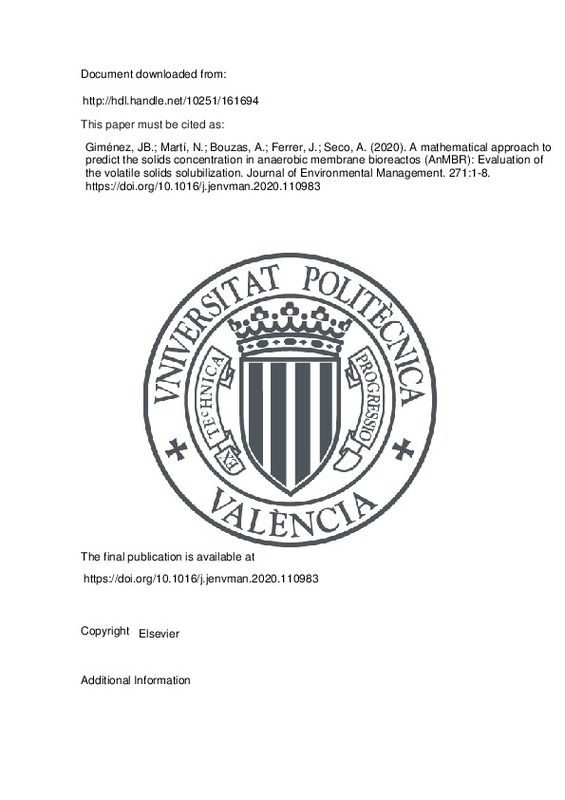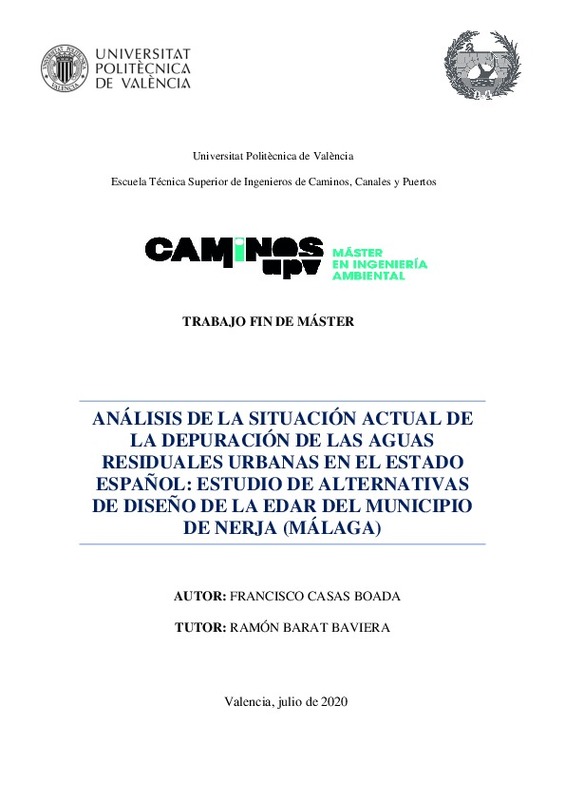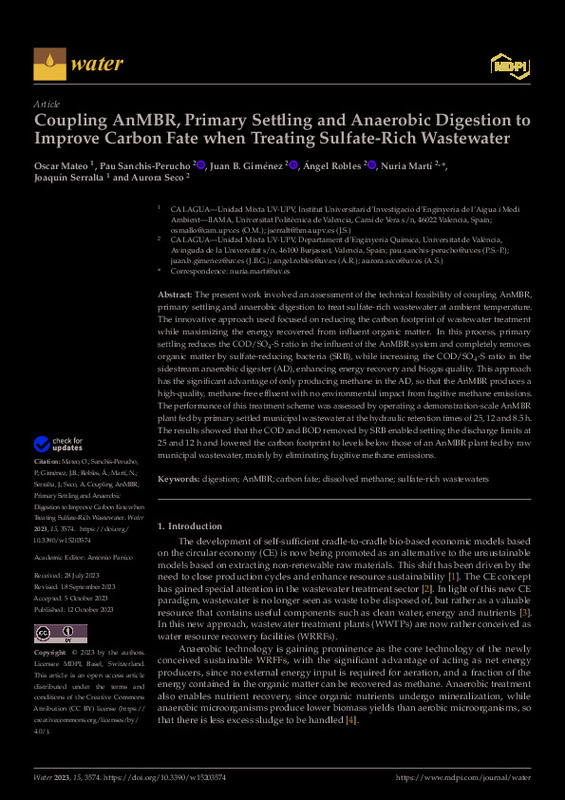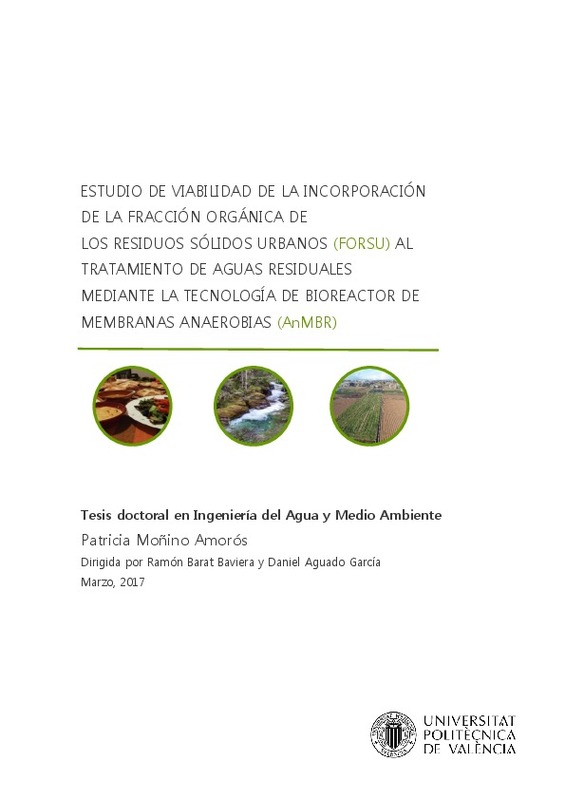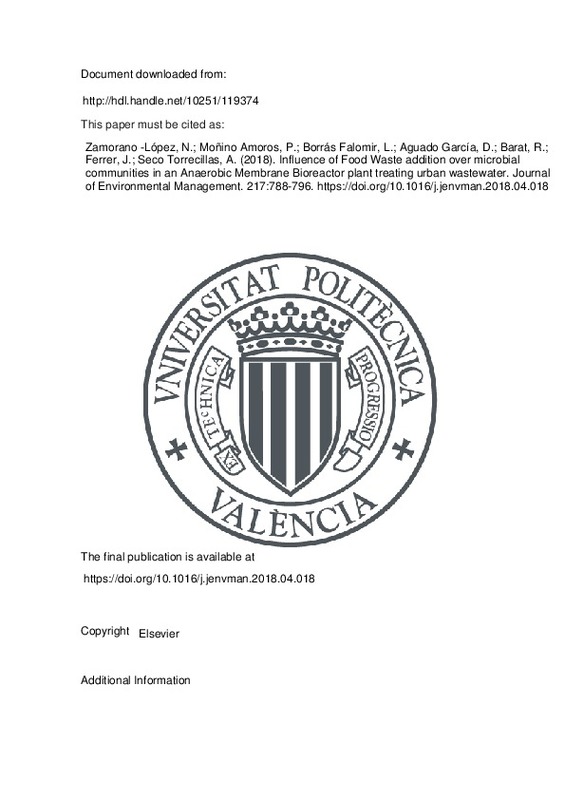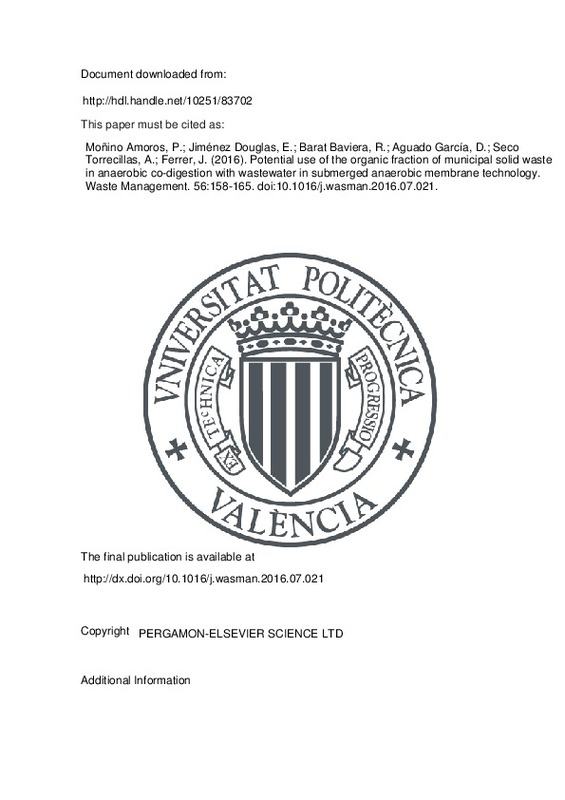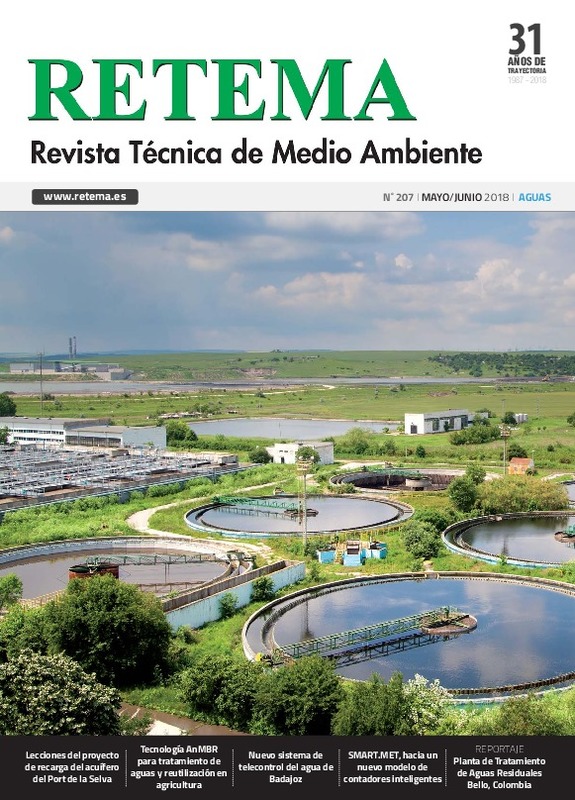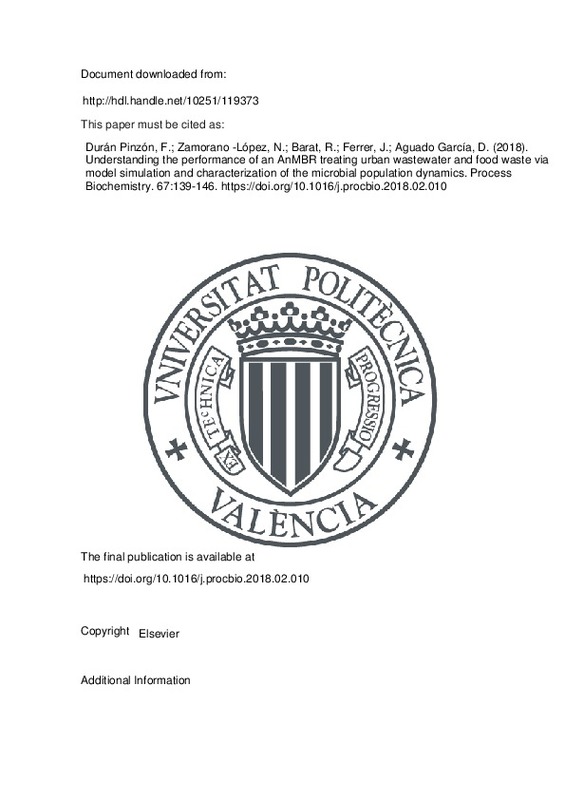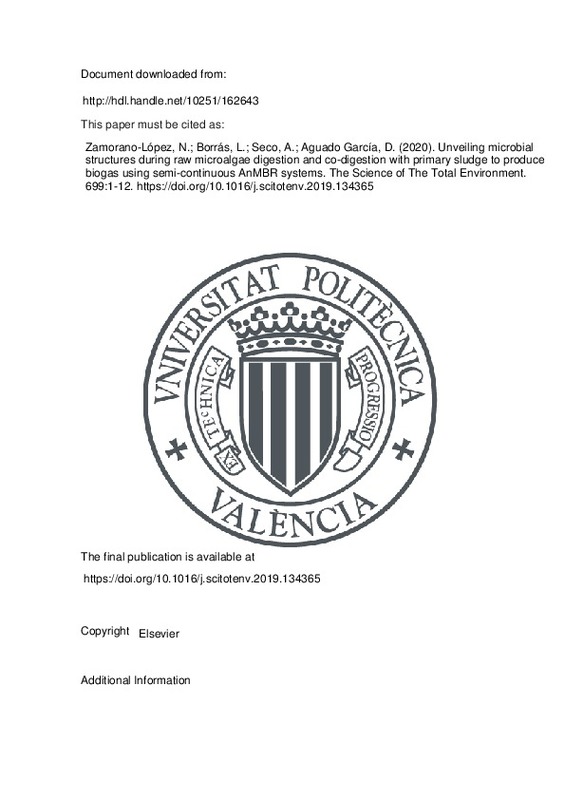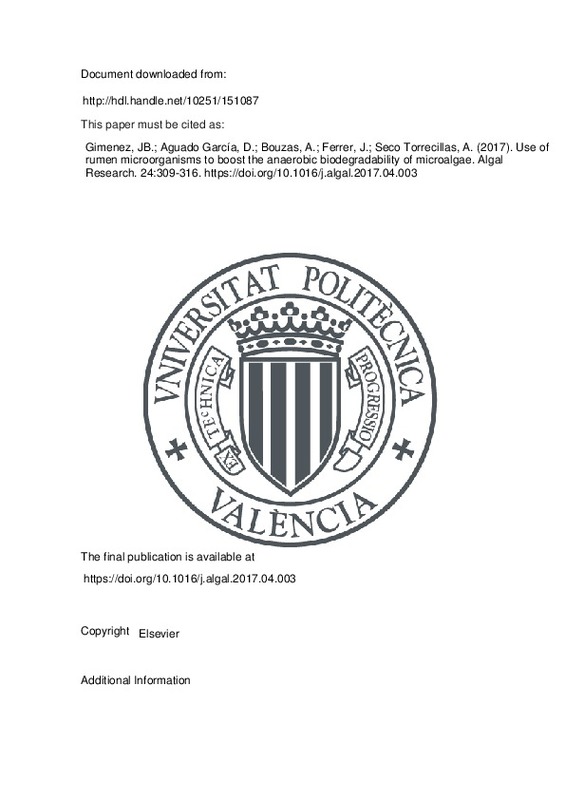

Listar por palabra clave "AnMBR"
RiuNet: Repositorio Institucional de la Universidad Politécnica de Valencia
- RiuNet repositorio UPV
- :
- Listar por palabra clave
JavaScript is disabled for your browser. Some features of this site may not work without it.
Buscar en RiuNet
Listar
Mi cuenta
Ayuda RiuNet
Admin. UPV
Listar por palabra clave "AnMBR"
Mostrando ítems 1-17 de 17
-
Giménez, Juan B.; Martí, Nuria; Bouzas, Alberto; FERRER, J.; Seco, Aurora (Elsevier, 2020-10-01)[EN] Anaerobic Membrane Bioreactors (AnMBR) are gaining attention as a suitable approach for sustainable low-strength wastewater treatment, as they bring together the advantages of both anaerobic treatments and membrane ...
-
Sánchez Cota, Raúl (Universitat Politècnica de València, 2017-11-08)[ES] El presente estudio trata de comparar el rendimiento en la eliminación de nutrientes, nitrógeno amoniacal y ortofosfato, presentes en agua residual procedente de un reactor anaerobio de membranas (AnMBR) mediante ...
-
Casas Boada, Francisco (Universitat Politècnica de València, 2020-09-29)[ES] Resumen español o valenciano (máximo 5000 caracteres): A raíz de la Agenda 2030 que la Organización de las Naciones Unidas (ONU) aprobó en 2015 sobre el Desarrollo Sostenible y tras la condena en julio de 2018 al ...
-
Ruiz-Barriga, Patricia; Serralta Sevilla, Joaquín; Bouzas, A.; Carrillo-Abad, Jordi (Elsevier, 2024-09)[EN] This work describes a comprehensive assessment of operating parameters of a bench-scale electrodialysis (ED) plant for nutrient concentration from an Anaerobic Membrane BioReactor (AnMBR) effluent. The ED bench-scale ...
-
Mateo, Oscar; Sanchis-Perucho, Pau; Giménez, Juan B.; Robles, Ángel; Martí, Nuria; Serralta Sevilla, Joaquín; Seco, Aurora (MDPI AG, 2023-10)[EN] The present work involved an assessment of the technical feasibility of coupling AnMBR, primary settling and anaerobic digestion to treat sulfate-rich wastewater at ambient temperature. The innovative approach used ...
-
Adeva Gil, Lidia (Universitat Politècnica de València, 2021-07-29)[ES] El objetivo principal es diseñar la EDAR de Almansa para que sea capaz de tratar el volumen de aguas residuales que le llegan, cumpliendo los requisitos de vertido y seleccionando el método que más se ajuste a las ...
-
Llácer Iglesias, Rosa María (Universitat Politècnica de València, 2017-11-08)[ES] La industria de alimentación y bebidas es un sector fuerte y un importante motor de la economía, generador de empleo, tanto en España como en Europa. Es asimismo un eslabón clave para el conjunto de la cadena ...
-
Moñino Amorós, Patricia (Universitat Politècnica de València, 2017-05-04)This Ph.D. thesis evaluates the joint treatment of WW and the organic fraction of the municipal solid waste (OFMSW) using the AnMBR (Anaerobic Membrane BioReactor) technology, obtaining methane-enriched biogas as a product, ...
-
Zamorano -López, Núria; Moñino Amoros, Patricia; Borrás Falomir, Luis; Aguado García, Daniel; Barat, Ramón; FERRER, J.; Seco Torrecillas, Aurora (Elsevier, 2018)[EN] Notorious changes in microbial communities were observed during and after the joint treatment of wastewater with Food Waste (FW) in an Anaerobic Membrane Bioreactor (AnMBR) plant. The microbial population was analysed ...
-
Yeste, P.; Barat, Ramón (Elsevier, 2019)[ES] El modelo matemático desarrollado en este trabajo incluye los distintos procesos que deben ser tenidos en cuenta a la hora de tratar el efluente de un reactor AnMBR. Estos procesos se encuentran relacionados ...
-
Yeste Donaire, Patricio Antonio (Universitat Politècnica de València, 2017-08-30)Wastewaters, which traditionally have been conceived as a waste with a high impact on public health and environment, begin to be considered in much of the world as a resource from a energetic point of view and for producing ...
-
Moñino Amorós, Patricia; Jiménez Douglas, Emérita; Barat Baviera, Ramón; Aguado García, Daniel; Seco Torrecillas, Aurora; FERRER, J. (PERGAMON-ELSEVIER SCIENCE LTD, 2016-07)Food waste was characterized for its potential use as substrate for anaerobic co-digestion in a submerged anaerobic membrane bioreactor pilot plant that treats urban wastewater (WW). 90% of the particles had sizes under ...
-
Godifredo-Calvo, Jesús; Ruiz, Laura; Hernández, Silvia; Serralta Sevilla, Joaquín; Barat, Ramón (MDPI AG, 2024-10)[EN] In the framework of a circular economy, wastewater treatment should be oriented toward processes that allow the recovery of the resources present in the wastewater while ensuring good effluent quality. Nitrogen recovery ...
-
Seco Torrecillas, Aurora; Jiménez Benítez, Antonio Luis; Ruiz Martinez, Ana; Ferrer, J. (C&M Publicaciones SL, 2018)
-
Durán Pinzón, Freddy; Zamorano -López, Núria; Barat, Ramón; FERRER, J.; Aguado García, Daniel (Elsevier, 2018)[EN] An anaerobic membrane bioreactor (AnMBR) pilot plant treating kitchen food waste (FW) jointly with urban wastewater was run for 536 days. Different operational conditions were tested varying the sludge retention time ...
-
Zamorano-López, N.; Borrás, L.; Seco, A.; Aguado García, Daniel (Elsevier, 2020-01-10)[EN] Methane production from microalgae can be enhanced through anaerobic co-digestion with carbon-rich substrates and thus mitigate the inhibition risk associated with its low C:N ratio. Acclimated microbial communities ...
-
Gimenez, Juan B.; Aguado García, Daniel; Bouzas, Alberto; FERRER, J.; SECO TORRECILLAS, AURORA (Elsevier, 2017-06)[EN] A laboratory bioreactor using rumen microorganisms to treat Scenedesmus spp. biomass was operated for 190 days. At first the bioreactor operated as a Rumen-like Fermenter (RF) with a Sludge Retention Time (SRT) of 7 ...
Mostrando ítems 1-17 de 17

Universitat Politècnica de València. Unidad de Documentación Científica de la Biblioteca (+34) 96 387 70 85 · RiuNet@bib.upv.es


